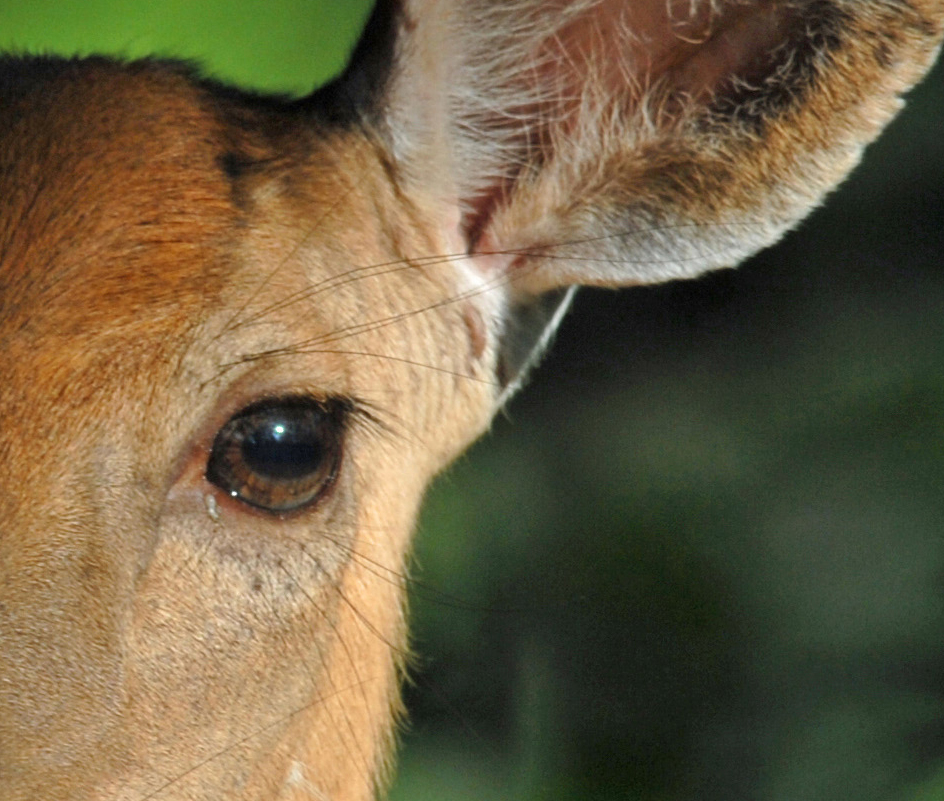Deer have an arsenal of senses to outwit potential predators. Ears like radar dishes; a nose that can sniff out a needle in a haystack; and eyes that seemingly see the very air we breathe. All working in concert!
But today we focus on those big, brown, beautiful eyes. Let’s start with the nuts and bolts.
Deer have a much higher density of rods in the retina than cones. Rods are photoreceptors and therefore are more sensitive to light but are not sensitive to color. Cones provide color sensitivity and high resolution vision.
Rods are more than one thousand times as sensitive as cones to light. Rod sensitivity is shifted toward shorter wavelengths (green) of the color spectrum peaking sharply in the blue and respond very little to red. Rods are also better motion sensors than cones.
A deer’s eye is equipped with a membrane, the tapetum lucidum, which reflects light back through the receptor layer of the retina passing light through the receptor layer twice. A deer’s eye also lacks a UV filter, unlike humans.
Pupil shape also plays a role in visual acuity. There are 3 basic pupil shapes: vertical, round, and horizontal. A recent study looked at pupil shape compared to a terrestrial animal’s ecological niche. Generally speaking, prey species have horizontal pupils while ambush predators have vertical pupils.
Conforming to the norm, deer have horizontal pupils.
Lastly, there is the placement of the eyes on the head. A deer’s eyes are on the sides of the head giving it a wide field of view.
So what does this all mean?
Even though deer have less than half the number of cones in the eye as humans, deer can still distinguish among different colors. During low-light conditions, deer are likely more sensitive to the blue to blue-green portion of the spectrum (due to the high rod density). Studies indicate that deer are less sensitive to light of long wavelengths (orange and red) and rely upon their perception of only 2 colors – yellow and blue.
Deer are essentially red-green color blind (like some people). Deer can distinguish blue from red, but not green from red. Red, orange, or green all look the same to a deer. Because deer lack a UV filter in their eye, their sensitivity to short wavelength colors is enhanced in the UV spectrum.
When are these colors of light most abundant? When the sun is below the horizon at dawn and dusk. What a coincidence! When are deer most active? Deer can see “more” in these low light situations because of the color spectrum visible to them and because the light is passed through the receptor twice.
So if you want to be “invisible” to deer don’t wear blue! Wearing blue makes you stick out like a sore thumb. And don’t wash your clothes in laundry detergent with UV brighteners.
Want to know if you glow in the woods? Test your clothes with a UV or blue light. You may be surprised by what you find.
Ok, now you know what colors to wear (or not wear). Onto movement. Deer may not be able to focus sharply on fine detail but shift your weight wrong once in the stand and you are done.
That high density of rods makes for great motion detection. This coupled with the placement of the eyes on the side of the heads allow deer to distinguish distant objects across a 310 degree field of view without moving their head. But that means deer have poor depth perception.
But what happens when a predator is detected? While a wide field of view is great for predator detection, you need to be able to see where you are going…in the woods…with trees…and branches…and logs…and bushes…to avoid being eaten!
Ever misjudge the height of a curb you are stepping off or the closeness of the counter you are placing that full glass of adult beverage? Not good!
Enter pupil orientation! Horizontal pupils improve image quality for horizontal contours in front of and behind the animal. This solves the problem of rapid flight in a forward direction despite lateral eye placement.
Whew! Thank goodness for that. Can you imagine the number of deer running into trees or poking their eyes with branches?
There is one last cool thing about deer eyes. Well, it is cool if you don’t have an eye phobia like me. I can scoop brains, sift through rumen contents, and dissect rotting carcasses with barely a nose crinkle. But show me an eyeball and I am completely creeped out. And this aspect of deer eyes completely creeps me out.
It’s obvious that deer move their heads in many different directions. For the horizontal pupil to be most beneficial, it should maintain alignment with landscape horizontal. Landscape horizontal changes based on head pitch (nose up or nose down). To maintain this horizontal pupil orientation, the eyes should rotate about the optic axes in response to head pitch. Because the eyes are lateral on either side of the head, the rotation needs to be opposite in direction for each eye. This phenomenon actually has a name – cyclovergence.
Low and behold, compensatory cyclovergence with head pitch is observed in mammals with lateral eyes. Therefore a deer maintains all the benefits of a horizontal pupil whether it’s feeding or walking through the woods. Cool – Yes! Completely Freaky – YES!
So when you hit the woods this fall, I wish you luck. Because given all the tools a deer has to outsmart you, you’re going to need it.
-Jeannine Fleegle, biologist
Deer and Elk Section
If you would like to receive email alerts of new blog posts, subscribe here.
And Follow us on Twitter @WTDresearch
